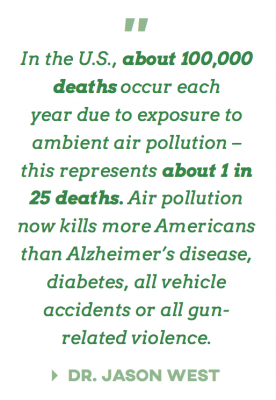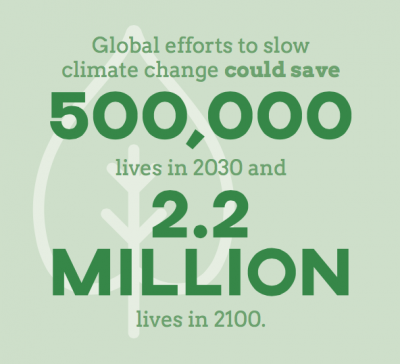Can we reduce deaths associated with air pollution?
October 15, 2017
Jason West, PhD
Associate professor of environmental sciences and engineering
Few people realize how many lives are lost each year to air pollution.
The best estimates today, consistent with estimates from my lab, suggest that about 4.5 million people die prematurely each year due to ambient air pollution exposure. This is about one in 12 deaths globally. This health burden is greater than that of any other environmental risk factor, and is comparable with risk factors such as high body mass index, high cholesterol and high sodium intake.
In addition to the deaths from ambient air pollution, roughly another 2.9 million deaths occur each year from exposure to very concentrated air pollution from burning solid fuels, such as wood and coal, to heat homes and cook. Overwhelmingly, these deaths occur in less-developed regions of the world, where many buildings lack proper ventilation.
Q: What is the current status of air quality in the U.S.? How about globally?
A: In the U.S., about 100,000 deaths occur each year due to exposure to ambient air pollution – this represents about 1 in 25 deaths. Air pollution now kills more Americans than Alzheimer’s disease, diabetes, all vehicle accidents or all gun-related violence. As terrible as the recent explosion of drug overdoses in the U.S. has been, air pollution still kills about twice as many people.
Air pollution simply has not gotten the attention it deserves, in part because it is not listed as the cause of death on any death certificate. Rather, it is a risk factor that influences several of the most common causes of death, including heart attacks, stroke, pulmonary disease and lung cancer.
 While the health burden is large, air quality in the U.S. has improved substantially since 1990. Starting with the 1990 Clean Air Act Amendments, air pollution regulations, along with advancements in vehicle and smokestack emission controls, have been instrumental in improving our country’s air quality. More recently, cheap natural gas and the growth of wind power have led to the closing of many old and inefficient coal power plants, with substantial benefits for air quality and health. Average life expectancy in the U.S. likely has increased by several months as a result of improved air quality alone.
While the health burden is large, air quality in the U.S. has improved substantially since 1990. Starting with the 1990 Clean Air Act Amendments, air pollution regulations, along with advancements in vehicle and smokestack emission controls, have been instrumental in improving our country’s air quality. More recently, cheap natural gas and the growth of wind power have led to the closing of many old and inefficient coal power plants, with substantial benefits for air quality and health. Average life expectancy in the U.S. likely has increased by several months as a result of improved air quality alone.
Despite this success, epidemiologic studies have shown that more benefits are to be gained from cleaner air, even below the current standards for pollution set by the Environmental Protection Agency (EPA).
On a global scale, air pollution currently is most severe in China, India and other areas that have a huge population exposed every day to heavily polluted air. China now shows signs that its leaders are turning a corner toward cleaner air, even as their economy and energy use continue to grow. In coming decades, Africa may emerge as the world’s most polluted region due to rapid population growth, increased use of energy and ineffective government regulation of air pollution.
Q: What does the future of air pollution look like?
A: I am optimistic, but I know that cleaner air will require a sustained effort. The U.S. and Europe already have improved air quality substantially and, despite current political efforts to weaken the EPA, I expect that this progress will continue through increasingly stringent regulations – in part because of the compelling effects of air pollution on public health. Elsewhere, e.g., in India and Africa, the situation probably will get worse before it gets better.
As the 21st century unfolds, climate change likely will be a significant driver of air quality. Climate change speeds the chemical reactions that form pollutants such as ozone. It increases pollution where rainfall becomes less frequent, and it increases emissions from trees and fires.
Addressing climate change, through reductions in greenhouse gas emissions, can result in huge benefits for air quality and health, as we move away from highly polluting fossil fuel energy sources. Switching from coal power plants to wind and solar, for example, reduces greenhouse gases and improves air quality, addressing climate change and air pollution at the same time.
 My lab has estimated that a global effort to slow climate change significantly would avoid about a half-million premature deaths from air pollution in 2030 and 2.2 million deaths in 2100. Our study also showed that the monetized benefits of these health improvements exceed the costs of reducing greenhouse gas emissions.
My lab has estimated that a global effort to slow climate change significantly would avoid about a half-million premature deaths from air pollution in 2030 and 2.2 million deaths in 2100. Our study also showed that the monetized benefits of these health improvements exceed the costs of reducing greenhouse gas emissions.
We are at a crossroads. Many nations want to improve their air quality, but there are choices in how to do that. We can continue to use fossil fuels while implementing increasingly sophisticated emissions controls, thereby reducing air pollution but not addressing climate change – or we can emphasize energy efficiency and non-fossil energy sources that will combat air pollution and climate change simultaneously.
My hope is that society will recognize climate change as the global crisis that it is – and choose the greener path.
Carolina Public Health is a publication of the University of North Carolina at Chapel Hill Gillings School of Global Public Health. To view previous issues, please visit sph.unc.edu/cph.
